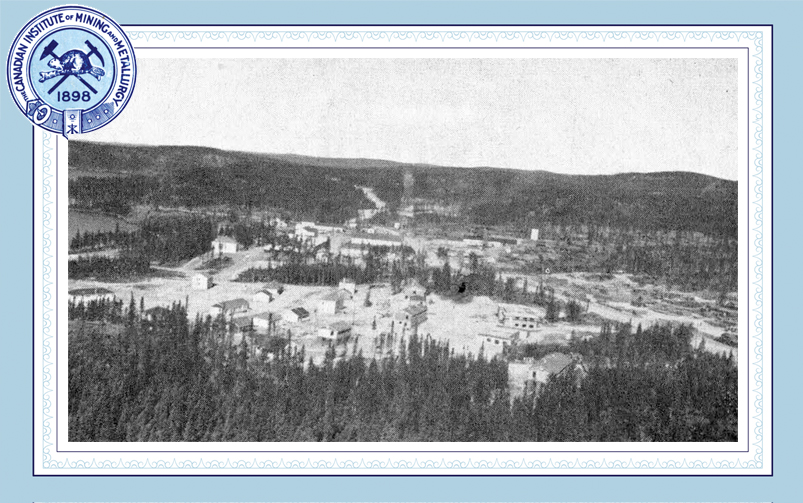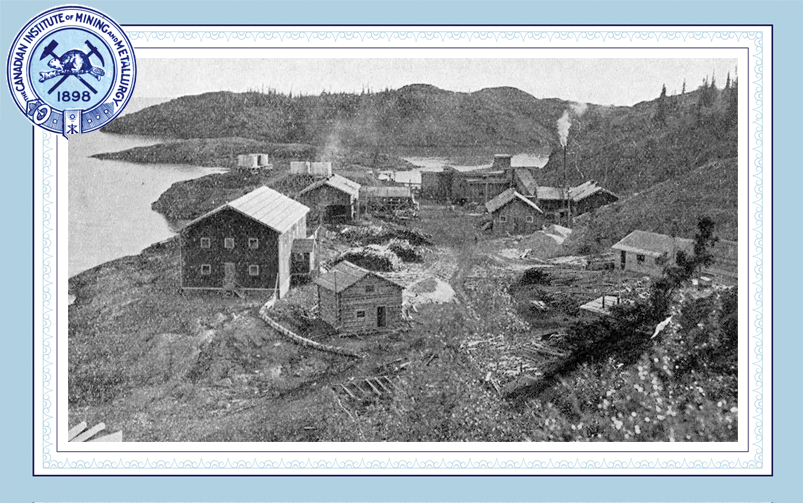The shaft that would be used to develop the A, B, C and E ore bodies at the Lynn Lake mine (CIM Bulletin, September 1950).
In CIM Bulletin in July 1953, J.A.H. Paterson wrote that “in a hitherto unopened area of northern Manitoba, a large operation is being brought to the point of production. Its planned and estimated output of nickel, copper and cobalt will of itself be a great addition to the mineral wealth of Western Canada.”
Sixteen years earlier, in 1937, Sherritt Gordon Mines began an active exploration program in the Lynn Lake area, approximately 240 kilometres north of its copper-zinc mine in Sherridon, Manitoba.
“Prospecting in this area was begun in 1937 and continued each year until 1941, when Austin McVeigh, a company prospector, found a patch of sulfides on a gabbro outcrop near a small lake named Lynn Lake,” wrote G.D. Ruttan (Trans., Can. Inst. Mining Met., Vol 48, 1955, pp. 339-348). “Samples from this sulfide indicated nickel and copper in significant amount.”
It was the first major discovery of nickel in Manitoba, according to D.G.E. Kerfoot (CIM Bulletin, June 1999), noting that the outcrop of sulfide-bearing rock found by McVeigh assayed 1.5 per cent nickel and one per cent copper. However, the company initially stayed quiet about this find. “With the Sherridon mine at full production for the war effort and manpower depleted by requirements of the armed forces, the company was in no position to follow up a discovery in this remote area,” wrote Kerfoot (1999).
In 1943, McVeigh carried out magnetometer work that disclosed a number of weak anomalies in low ground near the discovery, wrote Ruttan (1955).
It became more widely known by 1945 that Sherritt Gordon had discovered nickel-bearing sulfides in the area, wrote J.D. Allan (CIM Bulletin, September 1950). “Much attention was given to the Lynn Lake area in 1946 by mining companies, and in the winter of 1946-47 a major staking ‘rush’ developed,” he noted. “Hundreds of claims were staked from Lynn Lake to Barrington Lake, and hundreds of miles of lines were cut for geophysical surveys by the numerous mining company field parties.”
Allan also highlighted that magnetometers were “indispensable” in exploring for nickel in what was then a remote region. “Work done by Sherritt Gordon Mines has shown that the ore bodies cause magnetic ‘anomalies’ that can be detected by simple types of magnetometers. The magnetometer is an indispensable tool in searching for nickel in this region of scant outcrops,” he wrote. “The Lynn Lake area has been a favourable testing ground for geophysical methods of prospecting, and much has been learned about the application of the various methods.”
The Lynn Lake mine
According to Ruttan (1955), Sherritt Gordon’s discovery of the high-grade “EL” ore body in January 1947 was the turning point in the establishment of a mine at Lynn Lake. Kerfoot (1999) agreed that this discovery “finally established the presence of sufficient ore at Lynn Lake to warrant production.”
This was good news for Sherritt Gordon, as at the beginning of 1946, the company had estimated that its Sherridon mine only had enough ore reserves to support four more years of production. F.A. Forward (CIM Bulletin, November 1953) recorded that the Lynn Lake mine had a “proven reserve of over 14,000,000 tons of ore containing 1.223 per cent nickel, 0.618 per cent copper and additional cobalt values.”
“Eldon Brown, now president and managing director of the company, decided that the mining and milling plant from Sherridon would be utilized to equip the new mine at Lynn Lake,” wrote Kerfoot (1999). “At the same time, he obtained the agreement of the shareholders that all subsequent revenue from the copper mine should be applied to the cost of developing the Lynn Lake nickel mine. As a result, the company paid no dividends to its shareholders from 1946 until 1960.”
Mining operations at Sherridon ceased in September 1951. “Although many details of engineering and design remained to be worked out,” wrote Forward (1953), “sufficient information was available by the early months of 1952 to justify the decision to embark on a program of construction which included: building 144 miles of railway from Sherridon to Lynn Lake (by Canadian National Railways); constructing a 7,000 hp hydroelectric plant; moving the mining equipment, 2,000-ton mill and workmen’s houses from Sherridon to Lynn Lake; preparing to mine 2,000 tons of ore per day at Lynn Lake; and building a 75-ton per day ammonia plant and a nickel leaching and recovery plant at Fort Saskatchewan, Alberta, where many facilities, including low cost natural gas, were known to be available.”
According to W.G. Scott (CIM Bulletin, June 1956), the 144-mile Canadian National Railway line to Lynn Lake was constructed at a cost of $17 million.
Kerfoot (1999) noted that by the time the railway reached the Lynn Lake mine at the end of October 1953, over 40,000 tons of material, including 208 buildings from Sherridon, had been hauled in over the 165-mile winter road: “This operation sparked wide media coverage, and as Eldon Brown remarked in an interview with Time Magazine in June 1951, ‘Sherridon is one mining town that won’t end up as a ghost town.’”
Ore production from the Lynn Lake mine began on schedule in November 1953, and nickel concentrate was shipped by rail from Manitoba to Fort Saskatchewan, where the company was building a refinery that used a novel ammonia pressure leaching process to produce nickel, copper and cobalt from the concentrate made from Lynn Lake ore. Ruttan (1955) wrote that the first shipment of nickel left the refinery in August 1954.
R.W. Drybrough (CIM Bulletin, January 1965) recorded that by 1956, the production rate at the Lynn Lake mine was 750,000 tons per year, with 62 per cent coming from the main or “A” shaft and 38 per cent from the “EL” shaft. “Preparations were under way to attain a production rate in the neighbourhood of 1,250,000 tons per year and, to this end, sinking operations had started at the new Farley shaft and plans were also being made to deepen the “A” shaft and to increase the speed of the ore hoist,” he wrote. “The year 1956 also saw the beginning of construction of Sherritt Gordon’s second 7,000 hp hydroelectric development on the Laurie River.”
Subsequent operations
“Since 1960, two new mines have been discovered and brought into production in the general vicinity of Lynn Lake,” wrote L.H. Smith and D.S. Taylor (CIM Bulletin, January 1977). “The first of these was the Fox mine, a copper-zinc property operating at 3,000 tons per day from an underground operation. This mine started production in May 1970. The second operation is the Ruttan mine, another copper-zinc ore body. This mine started production in May 1973 at a rate of 10,000 tons per day from an open pit.”
The Lynn Lake mine closed in June 1976 after its ore reserves were depleted. “The town of Lynn Lake successfully survived the closure, thanks to the 1961 discovery of a copper-zinc ore body nearby, which supported Sherritt’s Fox mine from 1970 to 1985,” wrote Kerfoot (1999).
Production at the Fox mine began in 1970 at a rate of 3,000 tons per day, according to John G. Kelly (CIM Bulletin, January 1986). “Over 12.5 million tons will have been hoisted from the underground mine when the ore reserves are depleted in October 1985,” he wrote, adding that Sherritt was hoping to bring a gold mine into production near Lynn Lake in 1986.
Sherritt created and floated SherrGold in 1985, retaining a 60 per cent interest. The company started up its MacLellan gold mine in 1986, and it operated until 1989. “The start of construction of the MacLellan mine and mill was scheduled to phase in with the closure of the Fox copper-zinc mine located 48 km west of Lynn Lake,” wrote Robert Voisey and Robert J. Spencer (CIM Bulletin, November 1990). “The majority of the employees from the Fox operation were either employed at the MacLellan mine or relocated to Sherritt’s Ruttan operation.”
In January 2025, Alamos Gold announced that it plans to start construction on its Lynn Lake project—which includes the past-producing MacLellan mine—later this year, with initial production estimated to be in the first half of 2028.
Throughout 2025, we will continue looking back through the CIM archives for contemporary coverage of the discovery and development of major mineral deposits in Canada. All of the referenced papers can be accessed by CIM members through the OneMine portal at CIM.org.




